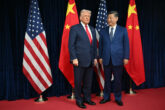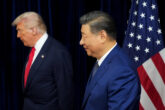
September 27, 2018
China in the World Podcast: The U.S. and China as Peer Competitors in the Indo-Pacific
The Trump administration has taken a more confrontational approach to bilateral relations with China, implementing tariffs on nearly half of all Chinese exports to the U.S. and treating Beijing as a strategic competitor across many aspects of the relationship. In this podcast, Paul Haenle spoke with Abigail Grace, a research associate in the Asia-Pacific Security Program at the Center for a New American Security, on the changing dynamics of U.S. relations with China and the U.S. Free and Open Indo-Pacific strategy.
Grace discussed the evolution of U.S. foreign policy toward China, drawing on her experience in the National Security Council in both the Obama and Trump administrations. While President Obama focused on working with China to advance multilateral initiatives such as the Paris Climate Agreement and Joint Comprehensive Plan of Action (JCPOA), President Trump has made leveling the playing field for trade and economic relations the priority for the relationship. Grace argued that tariffs have been effective in shifting the focus of bilateral discussions to the economic relationship, but may not lead to any concrete progress on the fundamental strategic issues which the U.S. seeks to resolve. Language in the National Security Strategy labeling China a strategic competitor and revisionist power should not be framed negatively, Grace argued. Instead, such language recognizes Beijing’s elevated status and growing influence on the international stage. Grace said the Trump administration’s Free and Open Indo-Pacific and the Obama administration’s Pivot to Asia strategies both recognize the importance of U.S. engagement in Asia in the 21st century. The administration now faces the challenge of balancing its strategy’s economic, security, and governance components while at the same time upholding U.S. values.
Listen to this episode of the Carnegie-Tsingua Center's "China in the World Podcast" here.
More from CNAS
-
Chinese Maker of Bitcoin-Mining Machines Is a Security Threat, Says Expert
Bloomberg News reports that a Chinese manufacturer, Bitmain Technologies Ltd, that sells most of the world’s Bitcoin-mining machines — including 16,000 of them to a venture ba...
By David Feith
-
Indo-Pacific Security / Energy, Economics & Security
North Korea’s Provocations, Power Plays, and Shifting AlliancesTensions on the Korean Peninsula have reached a new and dangerous threshold. President Lee Jae Myung is warning of a real risk of accidental military clashes, as the situation...
By Dr. Go Myong-Hyun
-
Indo-Pacific Security / Energy, Economics & Security
How to Win the Economic War with ChinaTrump's approach to China has run aground, giving Beijing unprecedented advantage in the economic conflict....
By Edward Fishman & Julian Gewirtz
-
Indo-Pacific Security / Technology & National Security
Sharper: Tech + ChinaRecent talks between President Donald Trump and Chinese Communist Party General Secretary Xi Jinping placed a spotlight on emerging technologies, from high-end chips to minera...
By Charles Horn & Sevi Silvia




